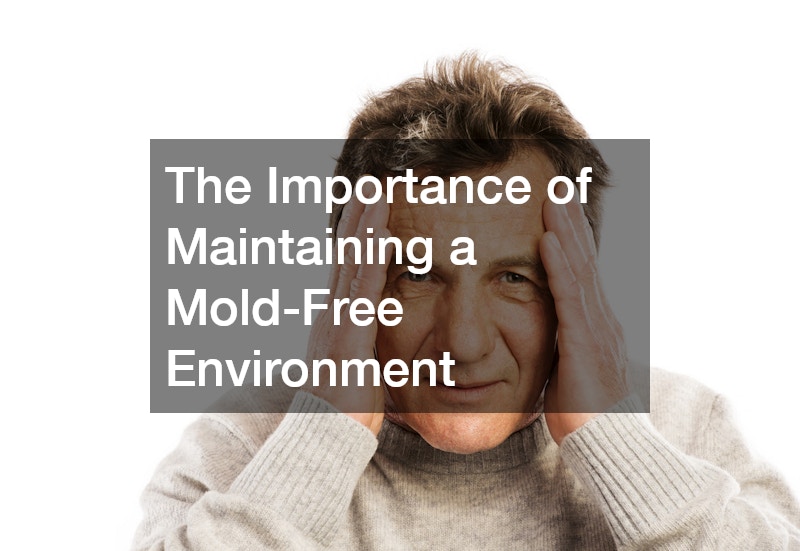Ensuring household safety is a multifaceted endeavor that covers a wide range of areas within and around the home. As families spend more time indoors, prioritizing aspects like air quality, structural integrity, and environmental risks is critical. This article dives into essential strategies for creating a secure and healthy living space, aiming to protect your family and improve the overall quality of your home environment.
Homeowners need to be vigilant about potential safety threats and take proactive measures to address them. Though some hazards may be more visible, many others lurk quietly, posing significant risks if left unchecked. Understanding these issues is the first step towards achieving comprehensive household safety.
This guide provides detailed insights and practical advice on maintaining a safe home environment. We will cover key areas, from identifying hidden risks in older homes to effective pest control strategies, outlining how to safeguard your property and ensure peace of mind.
Creating a Healthy Home Environment for Your Family

Creating a healthy home environment is foundational to household safety and well-being. A primary focus should be on ensuring clean indoor air, as it directly impacts respiratory health, especially for young children and the elderly. Investing in a reputable duct cleaning service can help remove dust and allergens accumulated over time.
Proper ventilation is another critical aspect of maintaining a healthy interior climate. It helps reduce indoor air pollutants and prevents mildew growth, which can lead to respiratory issues if not controlled. Conducting regular mold remediation can address any growth caused by excess moisture.
Additionally, using non-toxic cleaning products contributes to a healthier indoor atmosphere. It reduces chemical exposure that can trigger allergies or other health problems. Educating family members about sustainable practices in daily living also supports a healthier lifestyle.
Identifying Hidden Dangers in Older Homes

Older homes often possess hidden dangers that can compromise household safety. One significant concern is the presence of asbestos, commonly used in construction materials before its hazards were known. Asbestos removal is crucial to eliminate this threat and avoid lung-related illnesses.
Lead paint is another typical risk factor in homes built before modern safety standards. Exposure to lead can have severe health implications, particularly for children, so testing and safe removal are essential steps. Regular renovations and updates can help uncover and mitigate these and other hidden risks.
Structural integrity can also degrade over time, leading to potential foundation issues. Homeowners should regularly inspect their properties for signs of wear and pursue timely foundation crack repairs to prevent more serious problems. Addressing these issues promptly aids in maintaining a safe home.
The Importance of Maintaining a Mold-Free Environment

Mold infestations are a prevalent issue that can affect household safety and health. Excess moisture, a leaky roof, or poor ventilation can create favorable conditions for mold growth. Mold remediation is essential to prevent the spread of mold and safeguard indoor air quality.
Besides structural damage, mold can trigger allergic reactions and asthma in susceptible individuals. Regular inspections and prompt water damage repair can help prevent mold from becoming an issue. Keeping humidity levels in check is also vital in reducing the potential for mold and mildew growth.
Mildew removal is equally important, as mildew often accompanies mold in damp areas. Ensuring that areas like bathrooms and basements have proper ventilation can minimize the risk. Utilizing dehumidifiers and exhaust fans can contribute significantly to maintaining a healthy home environment.
The Benefits of Keeping Indoor Air Fresh and Clean

Fresh and clean indoor air is integral to maintaining overall household safety. Poor air quality can have adverse effects on health, causing headaches, fatigue, and respiratory problems. Duct cleaning services help in preventing the accumulation of dust and pollutants within heating and cooling systems.
Incorporating houseplants can be a natural way to improve indoor air quality. Plants such as peace lilies and snake plants are known for their air-purifying qualities, adding aesthetic and functional value to your home. Ensuring that your home’s ventilation systems are in top condition is crucial to facilitating clean air circulation.
Additionally, the use of air purifiers can help remove airborne contaminants, offering another layer of protection. Regular maintenance of HVAC systems is essential in sustaining high indoor air quality. Educating family members on these practices contributes to a healthier living space.
How to Spot Tree Hazards on Your Property
Trees provide substantial beauty and shade to a property, but they can also become significant safety hazards. Identifying potential tree hazards is an essential aspect of household safety management. Regular inspections by a local tree company can detect issues such as dead branches and disease.
Warning signs include cracks in trunks, branches overhanging near structures, and signs of decay or fungal growth. Ignoring these could lead to fallen branches or even tree collapse during storms, potentially damaging property or harming individuals nearby. Consultation with arborists can help prioritize necessary tree removals.
Proactive management through regular trimming and pruning helps maintain tree health and minimizes safety risks. Homeowners should act swiftly if any tree threatens to compromise property safety. Ongoing monitoring and professional guidance are crucial to maintaining a secure outdoor environment.
Enhancing Safety with Regular Landscape Maintenance
Regular landscape maintenance is a key component of household safety that often goes overlooked. Well-maintained grounds prevent accidents caused by unkempt yards such as trips, falls, or plant overgrowth obscuring pathways. Employing a local tree company for expert guidance can ensure trees are safely managed.
Trimming shrubs and trees keeps them from interfering with walkways or obstructing views of driveways. Routine landscape services also improve visibility, deterring potential intruders by eliminating hiding spots. Integrating landscape care into regular home maintenance schedules promotes safety and aesthetics.
Seasonal checks should address additional landscape concerns like ice accumulation on walkways during winter. In the warmer months, ground bee control can prevent stings and allergic reactions. Homeowners can significantly enhance their family’s safety through diligent landscape management practices.
Managing Wildlife Around Your Home for Peace of Mind
Wildlife management is crucial, as animals can pose various household safety hazards. Animals such as raccoons, squirrels, and birds might seek shelter in attics or structures, causing damage. Contacting professional animal control services can help address these issues without harming the animals.
Securing trash bins and eliminating food sources can deter wildlife from invading your property. Preventative measures also include sealing any openings that animals could use to access indoor spaces. Effective wildlife management strategies contribute to a safer and more serene living environment for your family.
Advice from wildlife experts can aid in creating a balanced environment that respects local fauna while protecting the home. Maintaining a respectful distance from wildlife is crucial for safety and harmony. Implementing these practices helps keep homes free from unwanted animal interference.
Recognizing Signs of Structural Issues Before They Escalate
Structural concerns present a direct threat to household safety, making early detection essential. Visible warning signs like cracks in walls, unexplained dampness, or uneven floors may indicate underlying issues. Prompt foundation crack repairs prevent minor problems from becoming significant threats.
Hiring professional inspectors can provide peace of mind by evaluating the structural integrity of your home. Regular maintenance checks and repairs can secure the long-term stability of your property. Being vigilant about these signals allows homeowners to address potential dangers effectively.
Monitoring these structural aspects alongside routine home maintenance helps in early identification of serious issues. Addressing repairs early minimizes future costs and complications. Implementing a strategy for regular inspections can prevent structural issues from escalating.
Ensuring a Safe Outdoor Space: Tips for Tree Care
Ensuring a secure outdoor area around your home is critical for household safety. Proper tree care plays a significant role in this endeavor, as neglected trees can become hazards. Regular consultations with tree care professionals help maintain tree health and stability.
Investing in regular tree removals for damaged or dead trees can prevent property damage during storms. Additionally, ensuring trees are adequately spaced and pruned can enhance their health and longevity. Choosing native trees can reduce maintenance needs and increase environmental benefits.
Working with a local tree company ensures that tree management practices align with regional conditions and regulations. This partnership can provide valuable advice on tree selection, placement, and care. Safe outdoor spaces contribute significantly to the overall safety and enjoyment of your home.
Seasonal Considerations for Your Home’s Safety
Seasonal changes present unique challenges for maintaining household safety. Winter can bring risks such as ice accumulation on walkways and roofs, necessitating proactive management and maintenance. Preparing for cold weather through insulation checks and heating system maintenance is essential.
In spring and summer, considerations shift to preventing mold and mildew due to increased humidity levels. Appropriate ventilation and moisture control strategies help mitigate these risks. Ground bee control becomes crucial during these warmer months to prevent stings and allergic reactions.
Fall is an ideal time to clear gutters and inspect roofs for damage before winter begins. Creating a seasonal maintenance checklist can help homeowners stay ahead of these challenges. Managing these periodic hazards is a critical step in ensuring comprehensive household safety.
Keeping Your Home Safe from Unwanted Pests
Pests like rodents, insects, and termites pose various threats to household safety and structural integrity. Pest control services are essential for preventing infestations and mitigating damage before it escalates. Routine pest inspections can help detect early signs of infiltration.
Integrated pest management strategies can be effective in maintaining a pest-free home. These strategies combine preventive measures, monitoring, and targeted treatments to keep pests at bay. Sealing entry points and maintaining clean spaces can significantly reduce the risk of infestations.
Keeping a schedule for pest control not only protects your property but also promotes a healthier living environment. Engaging with professionals ensures that the most effective and environmentally friendly methods are used. Maintaining vigilance and prevention in pest control efforts is key to household safety.
The Role of Regular Home Inspections in Preventing Issues
Regular home inspections are a cornerstone of maintaining household safety and prolonging the life of your property. Professional inspections can identify hidden dangers and areas needing maintenance or repair. These assessments bring attention to potential issues before they become costly problems.
Inspections cover various aspects of a home, such as electrical systems, plumbing, and the condition of the roof. Addressing these findings promptly can prevent further damage and enhance the safety of your home. Scheduling annual or biannual inspections promotes proactive maintenance.
Homeowners can gain peace of mind knowing their home is regularly evaluated by experts. This ongoing attention to detail aligns with best practices for preserving property value and ensuring a safe living space. Incorporating regular inspections into your home maintenance routine is an investment in safety.
Effective Strategies for Maintaining Your Property’s Safety
Implementing effective strategies is vital for sustaining household safety over the long term. Routine tasks such as checking smoke detectors, changing air filters, and securing entry points deter potential hazards. Regular maintenance and updates are crucial for staying ahead of safety concerns.
Homeowners should create a comprehensive safety checklist to keep track of necessary tasks throughout the year. This checklist can include seasonal maintenance, pest control, and structural inspections. Consistent adherence to these routines ensures a secure and comfortable living environment.
Additionally, engaging with professionals for specific services like tree removals, pest control, and duct cleaning is vital. This partnership provides expertise and resources to maintain a high standard of safety. Effectively implementing these strategies reflects a commitment to preserving household safety.
Maintaining household safety requires a proactive approach to address potential risks both inside and outside the home. Through regular maintenance, inspections, and engaging professional services, homeowners can ensure a secure environment for their families. Comprehensive understanding of household safety measures is key to fostering a safe and healthy living space.
By recognizing and mitigating hazards, individuals can enhance the longevity and comfort of their homes. Attention to detail and structured maintenance routines play crucial roles in safeguarding household safety. This detailed guide provides the necessary insights to address various safety concerns effectively.
Prioritizing household safety reflects a commitment to well-being and peace of mind for all family members. Implementing the strategies discussed will help maintain a resilient and secure living environment. Engage with specialists and utilize available resources to maximize safety and enjoy your home to the fullest.


